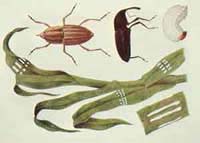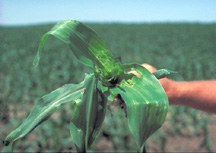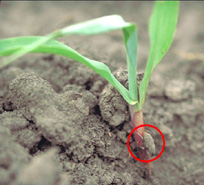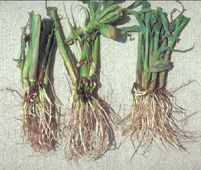Billbug
Calendra spp.

Figure 1. Billbug life cycle
Description
Billbugs are gray, brown, or nearly black snout beetles (Fig. 1). The adults of the many species range from 1/5 to 3/4 inch long. Billbugs play possum when disturbed but are rarely seen, because they hide in the soil during the day and are active only at night. The eggs, which they lay in plant stems, are white to gray and kidney-shaped. The adults frequently gouge out holes in unfolded leaves in which to lay their eggs, and these spots appear as a transverse row of punctures in the expanded leaves. The larvae, off-white, legless, brown to yellow headed, humpbacked grubs, feed in the center of the lower section of plant stems or in the roots. They pupate either in the stems or in the soil among the roots.
Life Cycle
Billbugs overwinter as adults in soil, coarse grass, or litter about the fields, becoming active when corn begins to come up. Although winged, billbugs seldom fly, but crawl over the ground in search of food. They will often migrate one-fourth mile or more. In addition to corn, billbugs attack nearly all cultivated and wild grasses, small grains, rushes, and cattails.
The adults feed at the base of the stalk, often below the ground level. They move from plant to plant at night, but stay hidden in the soil during the day, presumably to avoid the effects of the sun. Egg-laying starts about 10 days after the adults first feed. The females lay eggs in a hole they gouge in the stem with their mouthparts. It is not uncommon for a single female to deposit 200 eggs or more. The eggs hatch in 4 to 15 days. The small grubs feed and develop for several weeks in the center of the stalks, either below or just above the ground. Later, they descend to the soil and feed in or around the roots. Pupation occurs in the stems, roots, or soil. The adults, which transform in the fall, may remain in the pupal case or move out and feed before entering hibernation. The life cycle requires several months for completion, and there is only one generation each year.

Figure 2. Billbug damage
("Deadheart")
Damage
The larvae, or grubs, cause serious injury by feeding inside the stems and roots of small grains and cultivated grasses. This feeding causes the heads to bleach and the straws to fall or lodge. If several larvae feed within a stalk of corn, the chances that it will produce an ear are slight. The plants are usually stunted and easily recognized.

Figure 3. Adult Billbug on Corn
Scouting Procedures
Examine 20 plants in each of 5 locations and add the number of plants damaged to determine percent injury. Look carefully around the base of these plants and in the soil and debris to determine if adult billbugs are still present. A plant population count may also be helpful.

Figure 4. Billbug damage
("Suckering")
Threshold Guide
None established. Rescue treatments maybe warranted when the damage is widespread and the billbugs can be found. Treatments are not effective against grubs because they are internal feeders.